

Intensive Test Core & Flexible Intervention
Intensive Test Core and Flexible Intervention Option provides students in Grades K–8 with our SuccessK–8 Adaptive © learning curriculum. Intensive Test Core & Flex provides Grades 8–12 with our GradPoint Adaptive-Flexible© Prescriptive© and Sequential© online learning curriculum. All of our online courses are available for students 24 hours a day, 7 days a week, which allows our students to review course content that supports their intervention session, continue their learning in preparation for the upcoming session and preview and prepare for post-tests on any learning objective.
Intensive Test Core and Flexible Intervention Sessions are scheduled with your online supportive course. Sessions are scheduled with a certified and licensed teacher or interventionist to provide guidance, instruction and clarity on course and session activities.
Gifted Apples offers over 225 online learning courses and 66 elective course options, which include national general education development (GED) and college ACT and SAT college preparation. “The Nation’s Report Card is the only ongoing assessment of students’ performance in the U.S. in different subject areas.” 1
1Source: Retrieved July 10, 2016 from: http://www.nationsreportcard.gov/#?grade=4
Every student is provided with a premier digital learning curriculum that meets their needs. Students have the opportunity to work on flexible learning programs in reading, literacy, math, Writing and test preparation.
Practice test preparation is also provided for grades 4-12. Practice examination instruction and test strategies for all content and core subject tests are offered. Our practice test preparation includes preparation and instruction for quarterly and annual district and state-mandated tests.
Middle and high school students can enroll in one of our national SAT or ACT college test preparatory classes. Our SAT and ACT curriculum provides learning and practice test preparation in all content testing areas (e.g., English, reading, science, mathematics, social science and writing). Our Basic Skills Knowledge curriculum provides skills in math, science and literacy for 7th and 10th grade students who must take state and district proficiency tests and high school graduation competency tests. The Basic Skills curriculum is also a preparatory program for adult literacy learners before they enroll in their Graduation Equivalency Development (GED) option.
Adult learners who enroll in the Grade Equivalency Course (GED) Program to prepare for this test are assigned a Certified Teacher who will provide guided instruction in every area of this test. In our GED Program, adult learners can also enroll in individual courses that they may need to master, including any of the Basic Skills National Test courses, which will increase their knowledge in 9th–12th grade core subject content areas. Our Premiere course selection guarantees a quality curriculum that covers both the scope and depth of the subject students will learn.
Source: Retrieved July 10, 2016 from: http://www.nationsreportcard.gov/reading_math_g12_2015/
Adaptive© courses measure skills on an ongoing basis and align learning to the ability level of the student in the areas of reading, mathematics and writing.
The adaptive course curriculum continually adapts as your child moves through her or his learning activities and tasks. When a passage or math problem is challenging for your child, the Adaptive© program automatically provides prompts, giving opportunities to rethink the answer and then provides a sequence of steps necessary to understand the task. Finally, the Adaptive© program will revise the learning level on the particular task and learning moves forward.
Adaptive© Supportive Courses provides ongoing data so that your child’s teacher or interventionist can monitor progress and growth in some areas and “adapt” or adjust the level of difficulty where learning gaps still persist in the target skill areas. Adaptive © supportive courses also move students up several levels once concepts for higher levels are assessed and benchmark goals for the student’s age and grade level are met.
Prescriptive© Supportive Courses are designed to deliver knowledge to develop skills based on set “prescriptive” objectives and mastery levels assigned by the child’s teacher or interventionist. The Prescriptive© course curriculum can be designed based on the type of learner your child is, how your child learns and the specific learning needs that must be addressed. Prescriptive© courses deliver specific learning objectives that are targeted at your child’s greatest learning deficiencies. When a new prescriptive level is assigned, your child is assessed and progress is monitored. As prerequisite skills and concepts are learned, a higher “prescriptive” level is delivered. Students’ knowledge is cumulative, allowing them to proceed to the next prescriptive objective chosen by their teacher or interventionist. Assessment of learning is cumulative and mastery levels are usually set lower so that concepts can be learned to a greater degree, resulting in conceptual learning rather than memorized skills.
Sequential© Supportive courses deliver instruction in a sequence of steps until your child has achieved mastery of the learning goal. Course learning objectives are also sequenced in a scaffold-step-up manner. Skills that require prerequisite knowledge through explanation of topics, introduction of examples and learning of concepts by analogy are learned after your child has completed his or her pretest. Previously introduced skills are assessed to determine what learning activities are required for the student to achieve proficiency. Your child will always have the opportunity to go back and re-learn any skill that is necessary to achieve proficiency. If the learning achievement level is not met, your child will be able to re-test. In the Sequential© courses, the program will move your child to the next level until the learning goal is met.
Sequential© Supportive courses deliver instruction so that knowledge the student will learn builds or “scaffolds” on the previously acquired skill set before the next “sequence” of instruction is provided. Understanding of concepts is assessed for proficiency level before students are moved to a higher level in the critical learning sequence.
As with all of Gifted Apples learning options, there is an online computer learning course that is adaptive to your child’s ability level, a supportive course or aligns with the intervention learning option you have chosen. Once a baseline is established from your screening and assessment, the digital course provides interactive instruction that supports what your child is learning in her or his intervention sessions.
Interactive instruction with you or your child’s tutor via our online live virtual classroom while simultaneously logged into their online course will allow your child’s tutor or interventionist to teach the course, differentiate instruction when necessary and assess the degree of knowledge that your child is acquiring. Instruction occurs just like in her or his school classroom. The difference is that only your child and her or his tutor are in the learning environment, not 20 other students.
The culmination of both online supportive course learning and face-to-face intervention via our interactive learning platform allows your child’s tutor or interventionist to continually infuse learning and reading strategies that will be required for the progression of learning and assessment.
Once the online course is initiated, ongoing pre- and post-assessments measure progress on proficiency as well as areas requiring more skill development, adapting the instruction with differentiated learning tasks. Students are also administered four (4) evaluations by their teacher so that learning observations can be made under real test conditions.
Students can schedule to meet with their teacher when it is convenient for them to receive instruction, practice, take tests, complete homework, and ask questions—all from the comfort of their home. Students can log into their account at any time and work on their course, complete assignments and prepare for their intervention class, giving them more time for learning.
Gifted Apples’ adaptive, sequential, and prescriptive supportive course programs provide flexible and differentiated instruction as well as ongoing assessment. All online learning sessions and live virtual classroom instruction are interactive and may be recorded so that you and your child can go back and review the learning objective and gain feedback on learning progress. Your child deserves to be a great reader. Call us today!
Intensive Transition Strategic Intervention
The focus at this level is to provide balanced reading and math intervention and transition learned reading and math skills to coursework and assignments that your child is learning in her or his classroom.
We believe that what a student learns with her or his tutor in the Gifted Apples intervention sessions must become applied knowledge or knowledge that is transferrable to other learning formats. In this learning option, students receive direct and explicit instruction on their class or homework assignments using the balanced literacy skills, reading strategies and new concepts that they are learning with their intervention tutor.
Transition intervention is important in that the knowledge your child acquires in the tutoring sessions and from the online course work must transfer to what she or he is learning and be useful in real-world settings. Your child’s science, social studies, geography, and English classes are where applied learning from their Gifted Apples’ intervention sessions must matter.
Source: Retrieved July 10, 2016 from:
http://www.nationsreportcard.gov/reading_math_g12_2015/
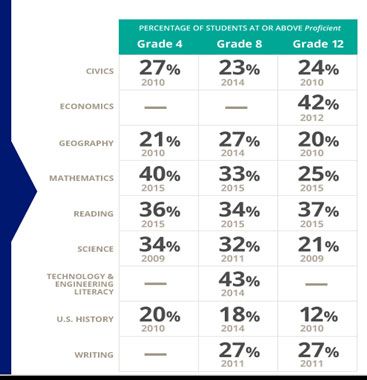
For this learning option, students must forward, email or upload their school assignments or current course material so that their intervention tutor can design the intervention learning plan and goals that focus on what is being taught in your child’s classroom. “The Nation’s Report Card is the only ongoing assessment of students’ performance in the U.S. in different subject areas.” 1
1 Source: Retrieved July 10, 2016 from: http://www.nationsreportcard.gov/#?grade=4
What Are the Learning Objectives of Transition Intervention?
- Transition Intervention is designed to close learning gaps in all subject areas, target and review core concepts and prepare students for high-stakes district and state tests.
- Transition intervention provides supplemental knowledge and balanced literacy instruction in vocabulary development, word comprehension, reading fluency and reading accuracy during close reading.
- Transition intervention provides instruction, learning and applying reading strategies automatically during the reading process.
- Transition intervention teaches students how to determine when to apply specific reading strategies based on page formats and text styles.
- Transition Intervention increases students background knowledge by wide reading of short stories from various genres within fiction and nonfiction.
- Transition intervention increases comprehension and retention of material by developing concepts about information that provide meaning.
- Transition Intervention develops better writing skills as students respond to written story passages and current articles in their journal logs, story maps or graphic organizers.
The Transition Intervention Option also provides balanced structured instruction that incorporates word knowledge, fluency of reading and comprehension, which are the foundational components of reading and, ultimately, reading to learn.


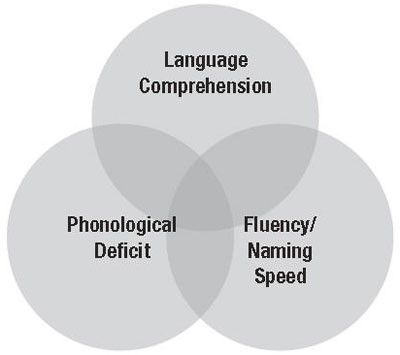
Transition Intervention is also supported by Gifted Apples’ Adaptive©, Prescriptive© or Sequential© curriculum, which provides flexible learning that is cumulative and builds upon previously learned material.
Pre- and post-test assessment and continuous, ongoing progress monitoring are integral parts of ensuring that your child is achieving success. All online learning sessions and virtual classroom interactions are digital and recorded so that you and your child can go back and review the learning objective and gain feedback on learning progress.
Your child’s tutor or interventionist will always provide explicit, direct and specialized instruction that supports transitional learning at the skill and conceptual levels.
Students can schedule to meet with their teacher when it is convenient for them and receive instruction, practice, take tests, complete homework and ask questions—all from the comfort of their home.
Students can log into their account at any time and work on their course, complete assignments and prepare for their transition sessions and online class, giving them more time to learn and master the content.
Intensive Prescriptive Math with Reading Intervention
Intensive Prescriptive Math with Reading Intervention provides balanced and foundational instruction for two core areas: reading and math. This learning option requires balanced reading intervention for one subject and intensive instruction on foundational math concepts for the second core subject area, math.
As a result of this concern, a mathematics reform process similar to what occurred in reading in the 1990s is now a reality of America’s educational focus, leading to scientifically-based instruction practices available to guide mathematics teachers.
Response to Intervention is a science of decision-making that can not only be applied to reading but also to the “learning challenges” of mathematics.
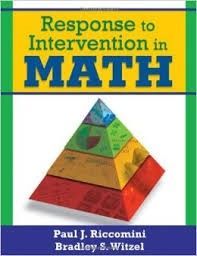
Gifted Apples’ researchers realize that developing math competence during primary and intermediate grades is essential to later success in math. Students who did not receive early intervention to repair deficits in math still struggle with math concepts, causing difficulty completing in-class math assignments and homework. Students who do not understand math during class time and find it embarrassing to constantly ask questions in the presence of their classmates will ultimately find their math homework challenging, leaving many unanswered problems unsolved. This continuous cycle throughout the school year ultimately leads to lower proficiency on math tests and, sadly, poor grades.
According to the National Assessment of Education Progress and the Nation’s Report Card (2013) data, only 40% of 4th graders and 33% of 8th grade students performed at or above proficiency on basic mathematics standards by the end of high school.

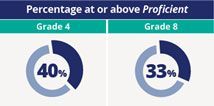
Source: Retrieved July 16, 2016 from:
http://www.nationsreportcard.gov/reading_math_2015/#mathematics?grade=4
NOTE: The NAEP mathematics scale ranges from 0–500. Black includes African Americans, and Hispanic includes Latinos. Race categories exclude Hispanic origin. Beginning in the 2014–15 school year, states could additionally categorize students as eligible for the National School Lunch Program (NSLP) by including them in their Community Eligibility Provision; therefore, the percentage of students categorized as eligible has increased in comparison to 2013. Readers should interpret the NSLP trend results with caution. See more information about the NSLP data at http://nces.ed.gov/nationsreportcard/mathematics/interpret-results.aspx.
Source: U.S. Department of Education, Institute of Education Sciences, National Center for Education Statistics, National Assessment of Educational Progress (NAEP), various years, 1992–2015 Mathematics Assessments.
Are the Nation’s 12th-Graders Making Progress in Mathematics and Reading?
The national average scores from the 2013 National Assessment of Educational Progress (NAEP) did not change from 2009. Among the 11 volunteer pilot states that participated in both the 2009 and 2013 assessments, 4 made gains from 2009 in mathematics and 2 made gains in reading.


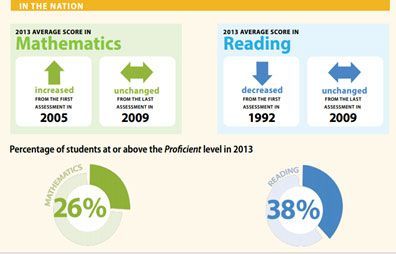
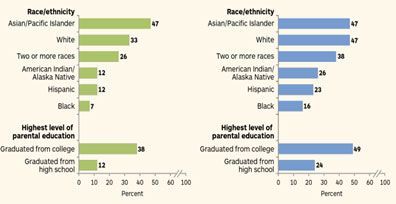


What are the Opinions of the Nation’s 12th Grade Students?
Gifted Apples’ tutors provide direct and explicit math instruction designed to ease the emotional challenges that secondary students feel after years of struggling in math classes and receiving low grades. The concept of “ease” is especially significant for mathematics, which involves many branches and strands, each with its own concepts and procedures.
The concept of “ease” in delivering math instruction cannot be stated enough. Our math tutors have years of experience and can anticipate misunderstandings and decrease confusion during the instructional process by providing precise explanations of math concepts while carefully sequenced and integrated instruction is being delivered. The purpose of this instructional format is to close learning gaps as quickly as possible.
The emphasis on drill and practice is structured so students understand the conceptual basis underlying the math processes for solving problems. Students can feel confident when a cumulative review is administered to assess the learning of their drill and practice activities.
Reading is infused into math instruction once word problem-solving begins. The foundational skills of reading (i.e., word meaning, fluency and comprehension) are taught as balanced, direct instructional targets and then applied to a variety of word-problem types.
- Instruction is organized and designed to teach students how to recognize concepts of varying problem types that they will encounter in their classroom instruction and on high-stakes school and district-mandated tests.
- The combination of in-depth drill and practice on conceptual math procedures, infusing reading foundational skills to comprehend mixed word-problem types, and ongoing formative and summative assessments provides students with familiarity with solving novel word problems.
- Students do not have to create a solution strategy each time they see a different word-problem format, but rather they will recognize various word problems as familiar using their set of solution rules learned from their Gifted Apples’ Math Tutor.

When students develop mental maps or "schemas,” for problem types taught in the Prescriptive Intensive Math sessions, they learn which set of solution rules to apply in order to solve a variety of word-problem types.
Our online mathematics courses range from basic math, algebra and geometry through high school calculus and pre-calculus. Our math tutors and interventionists also provide instruction on AP mathematics (e.g., differential equations) and college-level mathematics.
As with all Gifted Apples’ intervention options, the Math Prescriptive Intervention option is also supported with our Adaptive©, Sequential© or Prescriptive© online curriculum based on the student’s learning needs and ability level. Online classes provide flexible and differentiated instruction for any program choice.
Pre- and post-test assessment is ongoing so that your child’s tutor or interventionist can monitor progress and achievement at any point in their learning process.
Once a baseline is established, the digital course provides interactive instruction that supports what your child is learning in her or his intervention sessions.
After your child begins his or her online course, ongoing pre- and post-assessments measure progress on proficiency as well as areas requiring more skill development. The tutor or interventionist will adapt the instruction with differentiated learning tasks based on assessment results.
Pre- and post-test assessments are ongoing so that your child’s tutor or interventionist can monitor progress and achievement at any point in their learning process.
Students are also administered four (4) evaluations by their teacher so that learning observations can be made under real test conditions.
Students can schedule to meet with their teacher when it is convenient for them to receive instruction, practice unfamiliar material, complete homework, ask questions on challenging assignments, and prepare for tests—all from the comfort of their home.
Students can log into their account at any time and work on their course, complete assignments and prepare for their next intervention class or school class assignment, giving them more time for learning.
All online learning sessions and live virtual classroom instruction are interactive and recorded, so you and your child can go back and review the learning sessions and receive immediate feedback on the learning goals.
Intensive Diagnostic Reading Intervention

Dyslexia & The Older Reader
Many students struggle to learn to read for many reasons, including lack of motivation and interest, weak preparation from the pre-school home environment, weak English language skills, or low general intellectual ability (Snow, Burns, & Griffin, 1998).
Although it is challenging to provide appropriately targeted instruction for older students with dyslexia who continue to struggle with reading, it may be even more challenging to provide sufficient amounts of instruction in small enough groups to accelerate their development. Dyslexia is a specific learning disability that is neurological in origin. It is characterized by difficulties with accurate and / or fluent word recognition and by poor spelling and decoding abilities. Secondary consequences may include problems in reading comprehension and reduced reading experience that can impede the growth of vocabulary and background knowledge (Shaywitz, 2003, pp. 122-127).
Gifted Apples provides individualized, intensive reading interventions within a structured framework to:
- Students with specific reading disorders (Dyslexia);
- 4th grade and older students who struggle with reading
- Students at-risk for developing reading problems, including English language learners
Especially important are expert findings that:
- Students do not “outgrow” reading problems (Francis, Shaywitz, Stuebing, Shaywitz, & Fletcher, 1996; Juel, 1988; Torgesen & Burgess, 1998).
- If students do not receive high-quality instruction and intervention, early reading problems often develop into serious reading difficulties (Stanovich, 1986).
According to researchers, “effective early interventions, as well as remedial instruction that is powerful enough to accelerate students’ rate of reading growth, almost always involve extra small groups or 1:1 instruction for periods of time varying from 20 minutes a day to 90 minutes a day, four or five days a week” (Elbaum, Vaughn, Hughes, & Moody, 1999; Scamacca et al., 2007; Torgesen, 2005).
At Gifted Apples, our goal is to provide more powerful interventions to older dyslexic students than they may frequently receive in special education. It is also important for our students to acquire phonemic decoding skills if the instruction they previously received in the earlier grades was not sufficient to help them with the foundational reading component.
Over a quarter of 8th-grade students and more than one-third of 4th graders do not read well enough to understand important concepts and acquire new knowledge from grade-level text. For students with learning disabilities, the numbers are of greater concern.
Experienced educators and researchers have experienced the below-average reading performance of dyslexic readers, which is far below average even though they do not present with low or below-average cognitive abilities. If dyslexic students continue to struggle with reading during their early school experience, they have not acquired the skills from the reading instruction that has been provided. By the time many students with dyslexia reach 4th and 5th grade, they have missed out on so much reading experience that it may be a challenge for them to catch up and close the reading gap without intensive intervention.
Many scholars refer to older dyslexic students who are extremely behind in reading as "non-readers" due to the “nature and duration of instruction required to “normalize” the reading ability of the dyslexic reader.
Learners who are dyslexic yet do not receive intense interventions continue to struggle throughout their academic schooling with phonemic awareness and perform poorly on tests of phonemic decoding, text reading fluency, and spelling.
Gifted Apples provides explicit instruction in basic reading skills if students are still experiencing difficulty with decoding, fluency and comprehension. These foundational components of reading overlap, causing a “word reading bottleneck” (Fletcher et al., 2007) and inhibiting reading growth. It is important to continue to work to improve their functional reading skills, yet it does not make sense to allow a severe “bottleneck” in reading to stop the learning process that is required to be successful in a career, in college and in the world as an independent individual in society.
The primary differences between instruction appropriate for all children in the classroom and that required by children with relatively severe dyslexia are related to the manner in which instruction is provided.
Balanced structure means that each lesson is individualized within the word, with a fluency and comprehension framework supported by responsive reading instruction and a menu of strategies for each of the five critical areas of reading.
Gifted Apples provides a balanced approach to reading instruction where each foundational component is taught during every session, with a greater intensity of time and intervention given to each domain of reading as the instructional process moves forward.
The three foundational domains of reading are:
- Phonological (sound)
- Orthographic Speed Processing (fluency-speed naming of sound-to-letter correspondences required for reading; and
- Comprehension (organizing and retaining knowledge for learning)
Gifted Apples provides a balanced approach to reading instruction where each foundational component is taught during every session with a greater intensity of time and intervention given to each domain of reading as the instructional process moves forward.
Interventions that we provide are individualized within a framework and categorized into 5 areas that are critical to the reading improvement of older struggling readers: (1) word study, (2) fluency, (3) vocabulary, (4) comprehension, and (5) motivation.
Word Study: Phonological Processing and Phonemic Awareness
Explicit and direct instruction is provided to students who struggle with the phonological processing of phonemes in isolation, segments for blending sounds together, or decoding words and nonsense words. Vocabulary development of expressive and receptive language concepts Building background knowledge and conversational skills through read-alouds and think-out-louds about story elements (setting, characters and events)

Fluency Instruction
Gifted Apples provides explicit and intensive intervention to students who struggle with any area of oral reading fluency: speed, accuracy, expression, phrasing, prosody, intonation, and stress.
Gifted Apples’ Interventionists model and provide direct instruction in fluent reading so that students will be able to distinguish the difference between word-by-word reading and fluent phrasing. Students start fluency practice exercises by beginning with short phrases and progressing to more complex sentences.
Students record and listen to their own reading, as well as listen to recorded books of fluent reading, to acquire skills in stress intonation and phrasal prosody. Students practice fluency when different forms of punctuation are used.
From oral reading and recorded playbacks, students begin to learn text structure so that oral reading of punctuated sentences, self-monitoring and self-correction continue to motivate better reading practices.
With their interventionist, students practice using a variety of reading strategies (e.g., “shared reading,” “echo reading,” and “choral reading”) at their comfort level or instructional level before progressing to a more challenging or frustrating level.
Homework is designed to be fun and creative (i.e., Create a Poetry Notebook), while reinforcing the learning goal of each intervention session.

Comprehension Instruction
The ultimate objective of reading instruction is to enable students to understand what they read and gain understanding.
Scammacca (2007) states that it is extremely important to directly teach younger and older dyslexic students reading comprehension strategies because they lack early reading practice and have difficulties with word-level reading skills, which interfere with their ability to “acquire the range of reading strategies that good readers use to increase their comprehension.”
Gifted Apples provides intensive and explicit reading comprehension intervention in story plot retelling to recall events and details in sequential order, which link details together to identify the main idea. Students are provided with strategies to remember the main idea of each story chapter, understanding vocabulary terms and concepts that are basic to the text, plot, or meaning of the story. Students begin to develop “good readers” strategies for self-correction and self-monitoring strategies. Students begin to use text features to acquire important information before, during and after reading non-fiction literature.
Motivation and Reading
The last characteristic of effective instruction for students with dyslexia that differentiates it from instruction sufficient for most children is that it must be more supportive, both emotionally and cognitively. Acquiring the basic skills necessary for accurate and fluent reading is very difficult for students with dyslexia. Frustration and a lack of motivation can easily build up after years of struggling to read. This is why their need for more positive emotional support can be met by giving encouragement, positive feedback, reinforcement and even tangibles (tokens, stars, certificates, and prizes).
Motivation also requires carefully scaffolding the sequence of skills being taught and learned as well as the interactions during sessions of learned skills that were once extremely difficult.
English Language Learners as Students at Risk for Reading Problems:
English Language Learners: English Language Learners have become one of the largest subgroups of readers at-risk for reading difficulties. In the past decade, the number of English language learners has increased by 57% (Maxwell, 2009). English language learners need intensive reading support in all five critical areas of reading (e.g., phonemic awareness, phonics, fluency, vocabulary and comprehension). English Language Learners are students at-risk for reading difficulties and are a large subgroup of students who may enter school significantly behind in the fundamental skills of reading. English language learners show weaknesses in oral language knowledge necessary for reading comprehension and in the phonological and print-related knowledge required in learning to read words. It is necessary to provide direct and explicit instruction in how letters and sounds relate, with opportunities to practice these relations by reading texts that support second language learners.
All schools will need to provide instruction and intervention to meet the needs of a growing ELL population. English language learners continue to be at-risk for reading problems.
Gifted Apples provides explicit instruction in how letters and sounds relate, with opportunities to practice these relations by reading texts that support second language learners.
As with all of Gifted Apples learning options, there is an online computer learning application that is adaptive to your child’s ability level. Once a baseline is established, the digital course provides interactive instruction that supports what your child is learning in her or his intervention sessions.
As with all of Gifted Apples learning options, there is an online computer learning application that is adaptive to your child’s ability level. Once a baseline is established, the digital course provides supportive learning and allows for interactive instruction, which allows your child’s tutor or interventionist to always monitor and assess the degree of knowledge that your child is learning in her or his intervention sessions. The culmination of both online supportive course learning and face-to-face intervention via our interactive learning platform allows your child’s tutor or interventionist to differentiate the instruction for re-learning, revision of strategies, progression to the next level, and assessment.
Once the online course is initiated, ongoing pre- and post-assessments measure progress on proficiency as well as areas requiring more skill development, adapting the instruction with differentiated learning tasks. Students are also administered four (4) evaluations by their teacher so that learning observations can be made under real test conditions.
Students can schedule to meet with their teacher when it is convenient for them to receive instruction, practice, take tests, complete homework, and ask questions—all from the comfort of their home.
Students can log into their account at any time and work on their course, complete assignments and prepare for their intervention class, giving them more time for learning.
Gifted Apples Adaptive Sequential and Prescriptive Supportive Course Programs provide flexible and differentiated instruction as well as ongoing assessment. All online learning sessions and live virtual classroom instruction are interactive and recorded so that you and your child can go back and review the learning objective and gain feedback on learning progress.
References:
Elbaum, B., Vaughn, S., Hughes, M. T., & Moody, S. W. (1999). Grouping practices and reading outcomes for students with disabilities. Exceptional Children, 65, 399–415.
Fletcher, J.M., Lyon, G. R., Fuchs, L.S., Barnes, M.A. (2007). Learning Disabilities: From Identification to Intervention. New York: The Guilford Press
Retrieved on 02-27-2016 from: http://support.lexercise.com/entries/258401-Fletcher-Lyon-Fuchs-Barnes-2007-Ten-General-Principles-for-Instructing-Students-with-LDs-
Francis, D. J., Shaywitz, S. E., Stuebing, K. K., Shaywitz, B. A., & Fletcher, J. M. (1996). Developmental lag versus deficit models of reading disability: A longitudinal, individual growth curves analysis. Journal of Educational Psychology, 88, 3–17.
Juel, C. (1988). “Learning to Read and Write: A Longitudinal Study of Fifty-Four Children from First Through Fourth Grade.” Journal of Educational Psychology, 80, 437-447. Juel, C., Griffith, P.L., & Gough,
Scammacca, N.K., Roberts, G., Vaughn, S., Stuebing., K.K. (2015). A Meta-Analysis of Interventions for Struggling Readers in Grades 4-12: 1980-2011. Update of 2007
Retrieved on 04-01-2016 from: http://ldx.sagepub.com/content/early/2013/10/03/0022219413504995.abstract?rss=1
Stanovich, K. E. (1986). Matthew effects in reading: Some consequences of individual differences in the acquisition of literacy. Reading Research Quarterly, 21, 360–407.
Torgesen, J. K. (2005). Remedial Interventions for students with dyslexia: National hoals and current accomplishments. In Richardson, S., & Gilger, J. (Eds.) Research-Based Education and Intervention: What We Need to Know. (pp. 103- 114). Boston: International Dyslexia Association.
Torgesen, J. K., & Burgess, S. R. (1998). Consistency of reading-related phonological processes throughout early childhood: Evidence from longitudinal-correlational and instructional studies. In J. Metsala & L. Ehri (Eds.), Word recognition in beginning reading (pp. 161–188). Hillsdale, NJ: Erlbaum.
Retrieved on 03/01/2016 from: http://www.oecd.org/edu/ceri/primerondyslexia.htm
Intensive Diagnostic English Language Learner Reading Intervention
What is an At-Risk Reader?
Are ELL Students At-Risk for Reading Problems?
At-risk Readers are children who have difficulty with reading, resulting from a variety of factors and circumstances. The cause of reading is important, but the type of reading difficulties that prevent a student from reading and speaking fluently and learning from what they read is the primary focus of Gifted Apples’ Literacy and eLearning Tutors.
As an English Language Learner, your child may be at-risk for reading difficulties and continue to struggle with reading because the amount of instruction in English Language Development required to close the language gap cannot be provided during the academic school day. The language gap may result in poorer academic performance in all of your child’s content area classes (i.e., math, history, and science), not just reading or English.
With Gifted Apples’ ELL Tutors, your child will be provided with English Language Development instruction, which may include all or some aspects of each component, including the following interventions and strategies:
- The five foundational skills of reading (phonemic awareness, phonics, fluency, vocabulary and comprehension)
- Oral language development in academic vocabulary and conversational speaking
- English language development instruction using the features of English (sentence structure (syntax), grammar, vocabulary, pronunciation, and the use of social language)
Other reasons your child may need to begin at the fundamental skills level are:
- If your family has recently arrived in the U.S. from another country,
- If your child has never enrolled in school,
- If your child has experienced interrupted schooling,
- If she or he has attended school in the U.S. but has not learned basic blending and decoding skills and is not able to recognize words automatically
- If your child’s school does not have a Newcomer’s Program or English Language Development for ELL students
Especially important are research findings that:
The academic achievement of English language learners continues to be considerably low. On the 2007 National Assessment of Educational Progress (NAEP), fourth-grade English language learners' scores were 36 points below regular education students in reading and 25 points below regular education students in math. By the time English Language Learners reached eighth grade, they scored even lower in reading (42 points) and in math (37 points) than regular education students (Goldenberg, 2008).
As an English language learner, your child has become one of the largest groups of children at-risk for reading difficulties in America. In the past decade, the number of English language learners has increased by 57% (Maxwell, 2009). English language learners need intensive reading support in all five critical areas of reading (e.g., phonemic awareness, phonics, fluency, vocabulary and comprehension).
English Language Learners need intensive oral English language development (ELD), especially vocabulary and academic English instruction.
With an ELL tutor, your child will receive direct and explicit English language development instruction using the features of English (i.e., sentence structure (syntax), grammar, vocabulary, pronunciation and the use of social language). Our English Language Development Instruction will allow your child to have many opportunities and experiences practicing English in meaningful conversational contexts that relate to their life and culture.
The culture and language background of a student are very important in considering the assessment of reading for English learners. Standards of English may or may not be similar when learned in other countries. When the primary language is not English, the receptive and expressive language rules of the first language continue to be present in the second language.
English language development involves building background knowledge with vocabulary words. Words are used to introduce new concepts that are related to a cultural theme of interest to ELL students. Several lessons can be structured around a concept or theme.
- Learning is guided so that your child will learn how to discuss and write about concepts from the lessons she or he is working on with the ELL tutor.
- Your child will practice and learn numerous strategies, such as think-alouds, directed-reading-thinking activity and learning logs, which promote critical thinking and reasoning.
- Your child will learn how to clarify confusing information and predict what might happen as they read short passages.
- Critical-thinking strategies will provide knowledge of concepts rather than encouraging memorization of single skills.
- Your Gifted Apples ELL Tutor will model thinking out loud and how to clear up confusion during reading. Your child will receive direct and explicit instruction using a variety of “thinking-during-reading” strategies critical to learning what good readers do while reading silently.
- English and second language learners must learn concepts instead of individual skills in order to become proficient in the English language used for academic achievement.
Cultural themes that are meaningful in your child’s life and community will be used to encourage academic conversation connected to the language in their reading text.
Your child will gain meaningful knowledge when what is being taught, discussed and read connects to his or her everyday life.
Our Premiere online learning program provides numerous animated color visuals with sound, graphics, pictures, diagrams and charts that will provide understanding of concepts with supporting ideas for our English Language Learner students.
Animated visuals and graphics allow students to acquire a greater grasp of the English language and its underlying concepts and connected content.
Informal and Formal Assessment Methods
The culture and language background of a student are very important in considering the assessment of reading for English language learners.
Informal ~ Assessment
Your child’s ELL tutor will use a variety of authentic assessments that will give her or him an opportunity to demonstrate understanding of a particular story passage without mastering knowledge of advanced academic English language skills. ELL students will be able to demonstrate the skills they have acquired during intervention sessions by "thinking aloud" during a reading activity, writing in their learning log or double-entry journal, or during “reciprocal teaching” with their ELL tutor.
Formal ~ Assessment
Formal assessment begins with the case history and initial screening.
Case history of your child, which will include:
- Personal information
- Birth information
- Languages (primary and secondary)
- Medical History
- Educational history
- Family history of dyslexia or suspected dyslexia, learning disabilities, speech and language delays or environmental factors
- Parent and teacher questionnaire about your child’s social skills
Formal assessment measures are administered to determine:
Step 1: Problem Identification What’s the problem?
Step 2. Problem Analysis: Why is it occurring?
Step 3. Intervention Design: What are we going to do about it?
Step 4. Response to Intervention: Is it working?
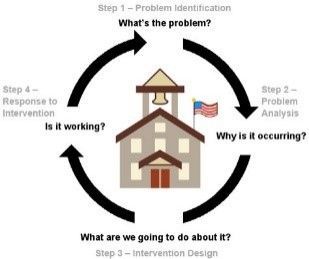

Grades 4–12 ELL Assessment of Foundational and Oral Language Reading Proficiency includes:
- Language: receptive and expressive language; morphological and pragmatic language skills
- Phonological Awareness: ability to identify and blend phonemes in words; manipulation of phonemes; hearing isolated sounds and blending to form words; recognition and production of rhyme
- Rapid Naming/Word Fluency: Speed of naming words or symbols
- Reading Fluency: Score of reading accuracy and rate
- Oral and Silent Reading Comprehension: Reading long and short printed passages
- Literal and inferential reading comprehension
- Spelling Writing: Relationship between phonemes and the spellings that represent sounds in written words; orthographic processing; semantic (meaning); and morphological (word parts: base, suffixes, and prefixes).
After screening and assessment, your child will begin on the reading component of the highest difficulty and will be provided with a complete and sequential progression of instructional intervention for the skills within that component, beginning with the most basic tasks, then moving on with sequential pacing to more complex tasks.
- Data from ongoing progress monitoring of reading growth is used to guide adjustments to interventions so that your child continuously receives instruction that effectively accelerates their reading growth on the target skills being taught.
Language Learning Instruction with Gifted Apples
Gifted Apples provides individualized, explicit and intensive reading intervention within a balanced and structured framework for older English language learners in grades 4 through 12.
- Explicit instruction occurs during each scheduled intervention session. Explicit and direct instruction refers to the level of intensity required to increase students’ phonological and phonemic knowledge, word fluency speed, and oral language text reading accuracy.
- Second language learners also require more intensive, direct instruction that is scaffolded and cumulative in order to maintain the knowledge they have acquired, building upon newly learned skills in order to decrease the severity of their symptoms.
- Decoding, Fluency and comprehension are the foundational components of reading, which overlap, causing a “word reading bottleneck” (Fletcher et al., 2007) and also inhibiting reading growth for English language students.
- Instruction is individualized within the framework of planning based on data from screening, standardized tests, pre-assessments and ongoing adaptive assessment to measure progress.
- Each lesson provides a “balanced structure” of the three foundational components of reading, which include the five (5) areas critical to improving reading.
- In scheduled amounts of time, intervention sessions cover word study, fluency, comprehension instruction and text-responsive writing to assess understanding.
- Instruction is sequential, scaffolded and cumulative, so that skills learned build upon one another along the learning continuum as the instructional process progresses forward.

Especially important are research findings that:
In later grades, English language students who have not received intensive interventions may still remain relatively impaired in phonemic awareness and will always perform poorly on tests of phonemic decoding, text reading fluency, and spelling.
Our Premiere online learning program provides numerous live visuals in color with sound and animated graphics, including pictures, diagrams, and charts, that help all students—especially English language learners—easily recognize essential information and its relationship to supporting ideas. Animated visuals and graphics allow students to acquire a greater grasp of the English language and underlying concepts connected to the content.
As with all of Gifted Apples’ learning options, there is an online computer learning application that is adaptive to your child’s ability level. Once a baseline is established, the digital course provides supportive learning and allows for interactive instruction. Your child’s tutor or interventionist will always monitor and assess the degree of knowledge that your child is learning in her or his intervention sessions. The culmination of both online supportive course learning and face-to-face intervention via our interactive learning platform is to provide your child’s tutor or interventionist with the ability to differentiate the instruction for re-learning, revision of strategies, progression to the next level, and assessment.
Once the online course is initiated, ongoing pre- and post-assessments measure progress on proficiency as well as areas requiring more skill development, adapting the instruction with differentiated learning tasks. Students are also administered two (2) evaluations by their teacher so that learning observations can be made under real test conditions.
Students can schedule to meet with their teacher when it is convenient for them to receive instruction, practice, take tests, complete homework, and ask questions—all from the comfort of their home.
Students can log into their account at any time and work on their course, complete assignments and prepare for their intervention class, giving them more time for learning.
Gifted Apples’ Adaptive©, Sequential©, and Prescriptive© Supportive Course Programs provide flexible and differentiated instruction as well as ongoing assessment. All online learning sessions and live virtual classroom instruction are interactive and recorded so that you and your child can go back and review the learning objectives and gain feedback on learning progress.
At Gifted Apples, we look forward to meeting you and your child.
Call
216.820.3800 or
440.755.9125
Gifted Apples’ Adaptive©, Sequential©, and Prescriptive© Supportive Course Programs provide flexible and differentiated instruction as well as ongoing assessment. All online learning sessions and live virtual classroom instruction are interactive and recorded so that you and your child can go back and review the learning objective and gain feedback on learning progress.
References:
Fletcher, J.M., Lyon, G. R., Fuchs, L.S., Barnes, M.A. (2007). Learning Disabilities: From Identification to Intervention. New York: The Guilford Press retrieved from: http://support.lexercise.com/entries/258401-Fletcher-Lyon-Fuchs-Barnes-2007-Ten-General-Principles-for-Instructing-Students-with-LDs-
Goldenberg, C. (2008). Teaching English Language Learners. American Educator, Summer 2007, AFT. Retrieved on 04-02-2016 from: http://www.aft.org/sites/default/files/periodicals/goldenberg.pdf
Maxwell, L. (2009, January 8). Immigration transforms communities. Education Week. Retrieved April 25, 2009.National Association of State Boards of Education. (2005). Reading at risk: How states can respond to the crisis in adolescent literacy. Alexandria, VA: Author.
The Nation’s Report Card (2007). National Assessment of Educational Progress at Grades 4 and 8. Retrieved 04-02-2016 from: https://nces.ed.gov/nationsreportcard/pdf/main2007/2007496.pdf
Send Us a Message
Send us a message using the form below or call us at 216-820-3800. We will respond to your inquiry as soon as possible.
Thank you for submitting the form. I will respond to your message within 24 - 48 hours.
Please try again later
Tutoring
Contact Information
Gifted Apples Reading and Math PreK–12, LLC, is a 501(c)3 non-profit organization
Business Hours
- Mon - Fri
- -
- Saturday
- -
- Sunday
- Closed


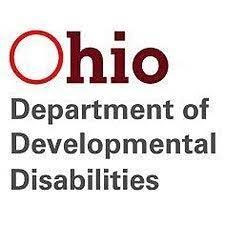
All Rights Reserved | Gifted Apples Reading & Math

